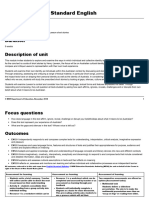Unit Planning
Uploaded by
api-534511306Unit Planning
Uploaded by
api-534511306UNIT PLANNING As laid out in Teaching
English by Design by
Peter Smagorinsky (2019)
A conceptual unit (4-6 weeks of 55min classes/2-3 weeks of 90min classes) asks the class to give
sustained attention to a related set of ideas as expressed by a variety of texts. "[Students] have an
active role in constructing new knowledge through their engagement with the unit concepts." (97).
TYPES: PARTS:
theme, archetype, genre, rationale, inventory, goals,
period, movement, region, assessment, lessons, activities,
works by a single author, discussions, texts, tools,
(103-110) learning a key strategy (97-103) composing
STAGE 1:
SELECTION +
JUSTIFICATION
The topic of a unit can be influenced by (111-117):
(Curriculum) curricular restrictions, overarching concept;
(Students) culture and community, developmental level,
needs; (Teacher) interests, knowledge
Justification comes from (121-128):
psychology or human development, cultural significance
(national, local, distant/global), future needs (college,
social), relevance, alignment with standards
STAGE 2:
MATERIALS
"Canon" vs. Student Interest
Things that influence materials (117-120):
tracking, literary value, variety of textual forms,
appropriateness, variety of authorship
STAGE 3:
CULMINATING +
IN-PROCESS
ACTIVITIES
Identify goals, then design (129-138):
In-process text and activities: exploratory,
collaborative activities to aid in student learning of
unit's objectives - not punitive, so okay to take risks
ex: response log, student-generated discussion
Culminating texts and activities: towards the end of
unit, more concerned with form expectations,
opportunities for new learning
ex: extended definition, multimedia project
STAGE 4:
INTRODUCTION
Designed to help students develop schematic knowledge
necessary for key unit concepts/problems (149-159)
Types: personal experience writing (150-153), opinionnaire or
survey (153-154), scenario or case study (154-157), writing
about related problems (157-159)
Created by Kylie Warkentin
Smagorinsky, Peter. Teaching English By Design: How To Create And Carry Out Instructional Units. 2nd ed.
Heinemann, 2019.
You might also like
- TLE IA Automotive Servicing Grades 11 12 PDF50% (4)TLE IA Automotive Servicing Grades 11 12 PDF8 pages
- MEES Lesson Plan Template Lesson 1 Submission 1 (1)No ratings yetMEES Lesson Plan Template Lesson 1 Submission 1 (1)8 pages
- 2018CreativityandCriticalThinkinginForeignLanguageTeaching Reid KovacikovaNo ratings yet2018CreativityandCriticalThinkinginForeignLanguageTeaching Reid Kovacikova14 pages
- Curriculum Perspectives: Compiled by Irfan Fajrul Falah0% (1)Curriculum Perspectives: Compiled by Irfan Fajrul Falah12 pages
- Lesson Plan: Week 1: Period) - Worksheets (90 Copies)No ratings yetLesson Plan: Week 1: Period) - Worksheets (90 Copies)5 pages
- Annotated Learning Plan Template ELEMENTARY & SECONDARYNo ratings yetAnnotated Learning Plan Template ELEMENTARY & SECONDARY3 pages
- Annotated Learning Plan Template ELEMENTARY & SECONDARYNo ratings yetAnnotated Learning Plan Template ELEMENTARY & SECONDARY3 pages
- Instructional Design Theories, History & ModelsNo ratings yetInstructional Design Theories, History & Models35 pages
- English Standard s6 Henry Lawson Unit Module ANo ratings yetEnglish Standard s6 Henry Lawson Unit Module A22 pages
- Flend Your Class For Better Student Engagement100% (1)Flend Your Class For Better Student Engagement10 pages
- MYP Unit Planner: INQUIRY: Establishing The Purpose of The InquiryNo ratings yetMYP Unit Planner: INQUIRY: Establishing The Purpose of The Inquiry4 pages
- Module C Lesson Ten: Essential QuestionsNo ratings yetModule C Lesson Ten: Essential Questions5 pages
- Week One - Friday - Mathematics Lesson PlanNo ratings yetWeek One - Friday - Mathematics Lesson Plan4 pages
- Lesson Plan Inquiry Project Based Learning 1100% (1)Lesson Plan Inquiry Project Based Learning 13 pages
- WIL Student Teacher Fill-In Lesson Plan Template UPNo ratings yetWIL Student Teacher Fill-In Lesson Plan Template UP5 pages
- Clay House Lesson Plan Grade 6 Webb PDFNo ratings yetClay House Lesson Plan Grade 6 Webb PDF11 pages
- Addition, Subtraction, Multiplication and DivisionNo ratings yetAddition, Subtraction, Multiplication and Division17 pages
- Let Reviewer 2020: Professional EducationNo ratings yetLet Reviewer 2020: Professional Education13 pages
- Department of Arts and Sciences Education UGE 1 - Course SyllabusNo ratings yetDepartment of Arts and Sciences Education UGE 1 - Course Syllabus9 pages
- Assignment 1 PST 2403 - Advanced Pedagogy in Comp Sci Ed Makuni FortunateNo ratings yetAssignment 1 PST 2403 - Advanced Pedagogy in Comp Sci Ed Makuni Fortunate6 pages
- Behind The Scenes Photo of Olivia Hussey and Leonard Whiting On The Set of Romeo and Juliet, Dir. Franco Zeffirelli (1968)No ratings yetBehind The Scenes Photo of Olivia Hussey and Leonard Whiting On The Set of Romeo and Juliet, Dir. Franco Zeffirelli (1968)7 pages
- Modern Approaches in Language Teaching Summary of MethodsNo ratings yetModern Approaches in Language Teaching Summary of Methods8 pages
- Foundations of Higher Education SyllabusNo ratings yetFoundations of Higher Education Syllabus4 pages
- Using Constructivist Teaching Strategies To EnhanceNo ratings yetUsing Constructivist Teaching Strategies To Enhance7 pages
- Detailed Lesson Plan (DLP) Format Instructional Plan (Iplan)100% (2)Detailed Lesson Plan (DLP) Format Instructional Plan (Iplan)2 pages
- Video Courses For Coaches and Physical Educators: Fall 20110% (1)Video Courses For Coaches and Physical Educators: Fall 201110 pages
- PGCE Secondary Computer Science HandbookNo ratings yetPGCE Secondary Computer Science Handbook47 pages
- Essential Science Primary 4 Teachers Guide100% (2)Essential Science Primary 4 Teachers Guide91 pages
- Q4 - LE - Mathematics 4 - Lesson 5 - Week 5No ratings yetQ4 - LE - Mathematics 4 - Lesson 5 - Week 515 pages
- Paul A. Longley, Michael F. Goodchild, David J. Maguire, David W. Rhind-Geographic Information Systems and Science-Wiley (2005)No ratings yetPaul A. Longley, Michael F. Goodchild, David J. Maguire, David W. Rhind-Geographic Information Systems and Science-Wiley (2005)605 pages
- Alternative Learning System (Als) Parent'S Orientation: SEPTEMBER 3, 2021 Cabuyao City, LagunaNo ratings yetAlternative Learning System (Als) Parent'S Orientation: SEPTEMBER 3, 2021 Cabuyao City, Laguna47 pages
- Restorative - Dentistry - SBRD - 2021 - FD 28 Nov 21 - 0No ratings yetRestorative - Dentistry - SBRD - 2021 - FD 28 Nov 21 - 0213 pages
- Preparing Teachers For Global Citizenship Education: A TemplateNo ratings yetPreparing Teachers For Global Citizenship Education: A Template50 pages
- Unit 3 Methods of Teaching Pakistan Studies: Week 5 and 6 Lectures: 13,14,15,16,17 and 18No ratings yetUnit 3 Methods of Teaching Pakistan Studies: Week 5 and 6 Lectures: 13,14,15,16,17 and 1845 pages






























































































